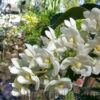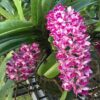# Arranging Dendrobium Anosmum (Đai Châu Orchids) in Living Spaces: A Comprehensive Guide

Dendrobium anosmum, commonly known as Đai Châu orchids, are celebrated for their striking beauty and fragrant blooms. With their cascading flower spikes and lush green foliage, these orchids can bring life and elegance to any living space. Whether you’re a seasoned orchid enthusiast or a novice gardener, understanding how to arrange these beautiful plants can enhance your home decor while ensuring their health and vitality. This comprehensive guide covers various aspects of arranging Dendrobium anosmum in your living space, including ideal locations, display techniques, and care tips to keep your orchids thriving.
## Understanding Dendrobium Anosmum
### Botanical Overview
Dendrobium anosmum is an epiphytic orchid native to Southeast Asia, particularly found in the forests of Vietnam, Thailand, and Malaysia. These orchids are known for their tall, slender pseudobulbs and clusters of fragrant flowers, which typically bloom in shades of white, purple, or lavender.
### Growth Requirements
To thrive, Dendrobium anosmum requires specific growing conditions:
– **Light**: These orchids prefer bright, indirect sunlight. Direct sunlight can scorch their leaves, while insufficient light can hinder blooming.
– **Temperature**: Ideal temperatures range from 20°C to 30°C (68°F to 86°F) during the day and slightly cooler at night.
– **Humidity**: High humidity levels (around 50-70%) are essential for healthy growth.
– **Watering**: Dendrobium anosmum should be watered thoroughly, allowing the potting medium to dry slightly between waterings.
Understanding these requirements is crucial for successful arrangements and maintaining their health in your living space.
## Choosing the Right Locations
When arranging Dendrobium anosmum in your home, the first step is selecting the right locations. Consider the following factors:
### 1. Natural Light
Position your orchids where they can receive plenty of bright, indirect sunlight. Suitable locations include:
– **Near Windows**: East or west-facing windows are ideal, as they provide gentle morning or evening light. If you have south-facing windows, consider using sheer curtains to diffuse direct sunlight.
– **Bright Rooms**: Placing your orchids in naturally bright rooms can enhance their growth and flowering potential.
### 2. Humidity and Temperature
Ensure the chosen locations maintain the necessary humidity and temperature levels. Consider placing your orchids in:
– **Bathrooms**: If well-lit, bathrooms can provide the humidity Dendrobium anosmum thrives in.
– **Kitchens**: The steam from cooking can help maintain humidity, provided there’s adequate light.
### 3. Avoiding Drafts
Avoid placing orchids in drafty areas, such as near air conditioning vents or open windows. Sudden temperature changes can stress the plants and hinder their growth.
## Creative Display Ideas
Once you have chosen suitable locations for your Dendrobium anosmum, it’s time to explore creative display ideas that enhance your living space while showcasing the beauty of these orchids.
### 1. Hanging Arrangements
Dendrobium anosmum’s natural growing habit makes them perfect for hanging arrangements. Consider the following methods:
– **Macrame Hangers**: Use macrame hangers to suspend your orchids from the ceiling or wall hooks. This not only saves space but also creates a stunning visual effect.
– **Wall-mounted Planters**: Install wall-mounted planters or shelves to create vertical gardens. This allows you to showcase multiple orchids in a compact area while adding depth to your decor.
### 2. Tabletop Displays
If you prefer tabletop arrangements, consider these ideas:
– **Plant Stands**: Use decorative plant stands to elevate your orchids, drawing attention to their beautiful blooms. Choose stands that complement your interior style.
– **Terrariums**: Create a mini orchid garden in a glass terrarium. Combine Dendrobium anosmum with suitable companion plants, such as ferns or moss, to create a lush environment.
### 3. Window Sills
Dendrobium anosmum thrives on window sills where they can receive ample light. Create an attractive display by grouping several orchids of varying heights and colors together. Use decorative pots that match your decor to enhance the overall look.
### 4. Centerpieces
Orchids make stunning centerpieces for dining or coffee tables. Consider the following arrangements:
– **Single Statement Plant**: Place a single, mature Dendrobium anosmum in an elegant pot as a focal point on your table.
– **Mixed Arrangements**: Combine Dendrobium anosmum with other flowering plants or greenery in a large bowl or container for a vibrant centerpiece.
### 5. Seasonal Decor
Incorporate Dendrobium anosmum into your seasonal decor. For example, during the holiday season, adorn your orchids with festive ribbons or ornaments. In the spring, pair them with pastel-colored decorations to celebrate the season.
## Maintenance and Care Tips
Proper care is essential to keep your Dendrobium anosmum healthy and thriving in your living space. Here are some maintenance tips:
### 1. Watering
– Water your orchids thoroughly when the potting medium feels dry to the touch. Avoid letting the roots sit in standing water, as this can lead to root rot.
– During the growing season (spring and summer), increase watering frequency, while in the dormant season (fall and winter), reduce watering.
### 2. Fertilizing
– Use a balanced orchid fertilizer every two weeks during the growing season. Dilute the fertilizer to half the recommended strength to avoid over-fertilization.
– During dormancy, reduce fertilization to once a month or cease altogether.
### 3. Pruning
– After flowering, prune spent flower spikes to encourage new growth. Use sterile pruning shears to prevent disease transmission.
– Remove any dead or yellowing leaves to maintain plant health and appearance.
### 4. Repotting
– Repot Dendrobium anosmum every 1-2 years or when the potting medium breaks down. Choose a well-draining orchid mix to support healthy root development.
– Repotting is best done after flowering when the plant is entering its active growth phase.
### 5. Pest Control
– Regularly inspect your orchids for signs of pests, such as aphids, mealybugs, or scale. If detected, treat infestations promptly using insecticidal soap or neem oil.
– Maintain good air circulation around your orchids to reduce the risk of fungal infections.
## Creating a Harmonious Environment
Arranging Dendrobium anosmum in your living space involves more than just choosing locations and display methods; it’s about creating a harmonious environment that promotes their health and beauty. Consider the following aspects:
### 1. Color Coordination
Choose pots and decorative elements that complement the colors of your Dendrobium anosmum. For example, if your orchids have purple blooms, consider using neutral or contrasting colors in pots and accessories to enhance their beauty.
### 2. Balance and Symmetry
When arranging multiple orchids, strive for balance and symmetry in your displays. Group plants of varying heights together, placing taller orchids towards the back or center and shorter ones in front for a visually appealing arrangement.
### 3. Incorporating Natural Elements
Bring nature indoors by incorporating natural elements into your displays. Consider using materials like wood, stone, or bamboo in your plant stands or pots to create a more organic feel.
### 4. Seasonal Themes
Adapt your arrangements to reflect seasonal themes. In spring, pair your Dendrobium anosmum with pastel colors and light fabrics. In autumn, incorporate warm tones and rustic elements to create a cozy atmosphere.
## Troubleshooting Common Issues
Even with proper care, Dendrobium anosmum may encounter some challenges in living spaces. Here are some common issues and solutions:
### 1. Leaf Yellowing
**Causes**: Leaf yellowing can be a sign of overwatering, nutrient deficiency, or insufficient light.
**Solutions**:
– Adjust your watering routine and ensure the potting medium dries out between waterings.
– Fertilize regularly during the growing season to address nutrient deficiencies.
– Move your orchids to a brighter location if they are not receiving enough light.
### 2. Poor Flowering
**Causes**: Insufficient light, inadequate fertilization, or improper temperature can lead to poor flowering.
**Solutions**:
– Ensure your orchids receive bright, indirect light for several hours each day.
– Fertilize appropriately during the growing season to promote blooming.
– Maintain temperatures within the optimal range for flowering.
### 3. Pest Infestations
**Causes**: Pests can thrive in warm, humid environments, potentially harming your orchids.
**Solutions**:
– Regularly inspect your plants for signs of pests.
– Use insecticidal soap or neem oil to treat infestations and prevent future occurrences.
– Maintain good air circulation and avoid overcrowding your orchids.
## Conclusion
Arranging Dendrobium anosmum in your living space not only enhances your decor but also allows you to appreciate the beauty and elegance of these stunning orchids. By understanding their growth requirements, choosing suitable locations, and employing creative display ideas, you can create a vibrant and harmonious environment for your orchids. With proper care and attention, Dendrobium anosmum will thrive, bringing joy and a touch of nature into your home. Embrace the beauty of these exquisite orchids and enjoy the serenity they bring to your living space.

